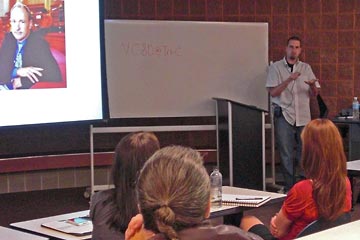SEPTEMBER 14, 2009
Web Standards
 With Tim Berners-Lee, creator of the World Wide Web, looking on from the screen, Brad Colbow explains Web Standards to a group of about 40 students at Tri-C Western Campus.
With Tim Berners-Lee, creator of the World Wide Web, looking on from the screen, Brad Colbow explains Web Standards to a group of about 40 students at Tri-C Western Campus.
Brad, designer-illustrator and owner of Brad Colbow Design, explained the need for standards by looking back on the early days of railroads when they ran on tracks of different widths. This prevented the rail connections needed for widespread travel. The Web in its early days was similarly a mishmash of competing technologies that didn't work together very well.
Web browsers, he continued, can be compared to the vehicles we use to travel on the highway. Just as any car, truck, motorcycle or other vehicle allows us to drive on the interstate, any browser should be able to travel the World Wide Web with ease.
Unfortunately this isn't always the case. In the late 1990s Microsoft and Netscape both tried to gain competitive advantage by developing special features that their browsers could do that the other couldn't. This of course made it difficult to create websites that worked well in all browsers.
Web Standards—continually being revised and refined the World Wide Web Consortium (W3C) and promoted by the Web Standards Project—are a set of common rules and practices aimed at guaranteeing that if the designer follows the rules, any browser will show the site the same way.
That's the goal, anyway. We're not there yet.
See for yourself
Video of Brad's talk, courtesy of Tri-C's Academic Excellence Center.
Top |
|
![]()
